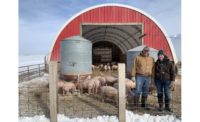It was inevitable: there would be more beef to sell in this third year of U.S. cow herd expansion. Better news emerged by spring: more of it would be premium quality. Even better by summer: the rancher, restaurateur and retail partners in the Certified Angus Beef ® (CAB®) brand were headed for another record year.
Sales of 1.121 billion pounds (lb.) marked an increase of 106 million lb., or 10.4% over last year. That makes CAB’s 39th fiscal year (FY) ending Sept. 30 one of its best, and part of a two-year, 25% rate of growth.
“This is more than a celebration of marbling,” CAB President John Stika said at the brand’s annual conference in September. “This is about relationships and the people who have elevated the relevance of this brand in the eyes of the consumer and across an entire industry.”
Encompassing seven of the 10 best sales months in CAB history, FY 17 set an 11th consecutive annual sales record, continuing a 13-year-streak of year-over-year growth.
The gratitude, Stika said, belongs first to the ranching families who meet consumer demand with “intentionality” and uncommon speed. Meaningful genetic improvement takes years, “but fortunately, the economic signals sent to producers have been loud and consistent, and they’ve responded in a big way.”
He credits a dramatic and positive shift in quality as producers rebuilt their herds.
“They literally and intentionally assembled the highest-quality, most Angus-influenced cow herd we’ve ever seen in North America,” he said. In fact, CAB’s 33 licensed packing plants saw a continued increase in Angus-type cattle identified, up 12% from last year to reach 15.2 million head.
After years of drought and downsizing, cattle replaced and bred with an emphasis on genetic and genomic potential entered the market. Access to that increased and focused supply led graders to certify a record of more than 87,000 carcasses per week, totaling 4.53 million for the year. That set an all-time high and annual CAB acceptance rate of 29.7%, more than double the 2006 rate.
Supported by a strong supply, CAB’s market share expanded as well. In 2006, only 6.6% of all fed cattle harvested through licensed packers were eligible to earn the brand name by meeting all 10 of its quality specifications, and 37.5% of fed cattle graded USDA Select. Lacking demand, the Select share fell to just 18% in 2017, eclipsed by the niche that took over mainstream market share at 18.4% for CAB.
Even so, the branded beef marketplace is more crowded, noisier than ever, Stika said, so licensed partners from a global network of more than 19,000 had to become even more innovative and forward thinking.
They met the challenge as CAB sales exploded in 49 foreign markets, reaching 174.5 million pounds–a 26.4% increase over last year and the best year ever for international sales. New markets include China, The Dominican Republic and Peru.
The brand’s retail division represented more than 40% of total sales in FY 17, setting a record of 456 million lb. sold. Lower prices generated more sales flow and opportunities to feature the brand in advertising. CAB’s top 50 licensed retail partners saw an average of 6.6% growth.
The foodservice division climbed 30 million lb. higher than last year to reach a record 385 million lb. sold. Licensed broadline distributors and specialty meat companies increased sales by more than 9%, while sales to licensed restaurants increased more than 12%, demonstrating the value of the brand to chefs who prize its consistent quality, and patrons who crave its flavor.
The summer season brought demand for ground beef and premium steaks, while roasts remained a staple for holiday celebrations and family gatherings.
Leading the charge were end meats with an 85-million-lb. increase, up 13.5% over last year, with ground beef sales growing by 1.7 million lb. to total 158.6 million lb. Sales of middle meats were up 8.4%.
Consumers also demanded 35.3% more CAB brand Prime in FY 17, lifting sales to 20.7 million lb.
The world’s largest and leading beef brand remains in a long-term growth trend, with partners who study the market to ensure it stays that way. Those who purchase balanced-trait registered Angus bulls at least average for marbling and ribeye area help supply the brand owned by Angus producers and sought by consumers who want Angus beef at its best.
Through management and genetic decisions that improve their herds and satisfy consumers, cattle producers stand to earn $50 or more per head as a share of the $50 million in grid premiums CAB cattle earn each year
“I still contend to this day that Certified Angus Beef allows us all to be a part of something bigger than ourselves,” Stika said.
Through an alignment of goals and philosophies, all are focused on the same quality endpoint.
Source: Certified Angus Beef






